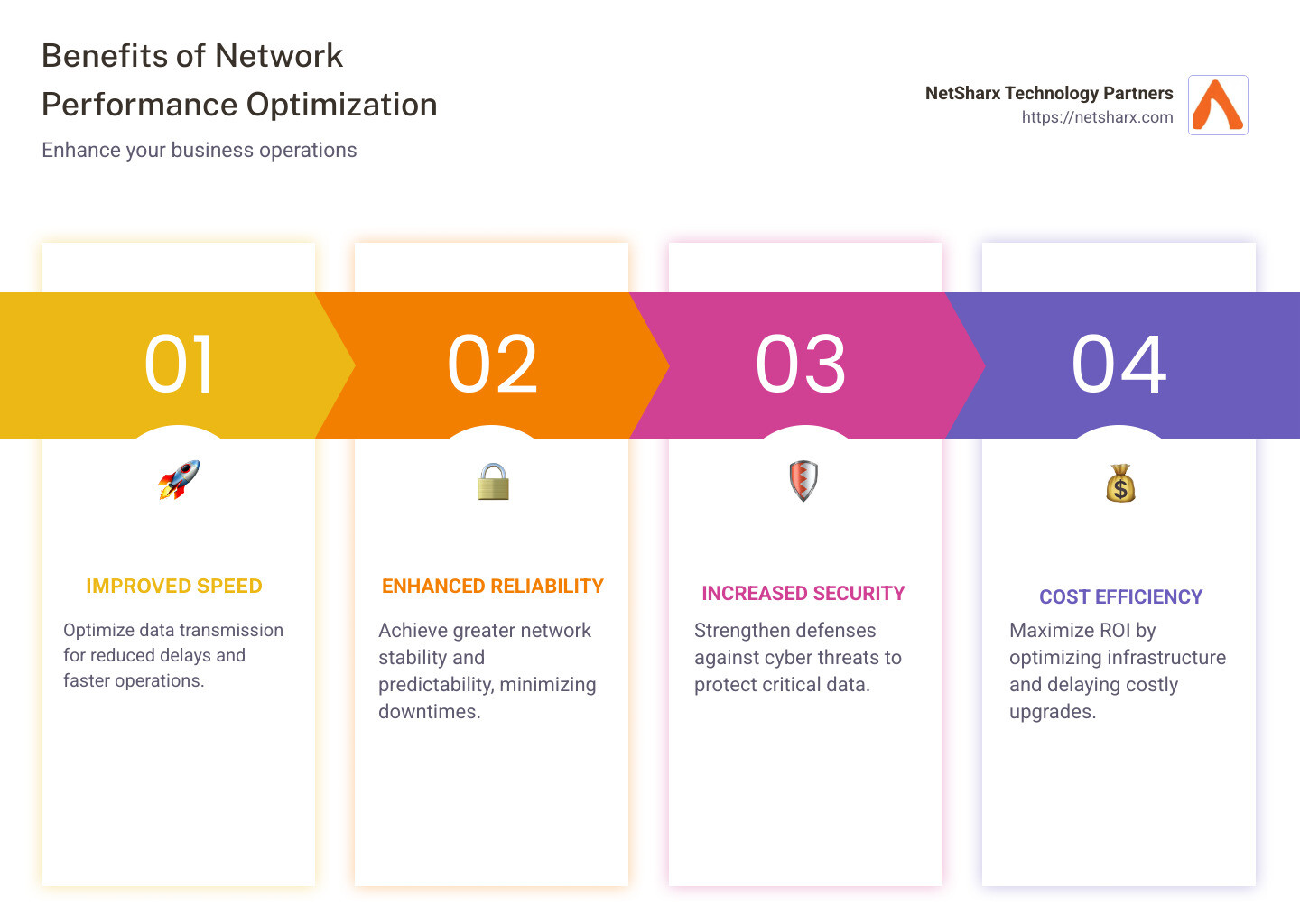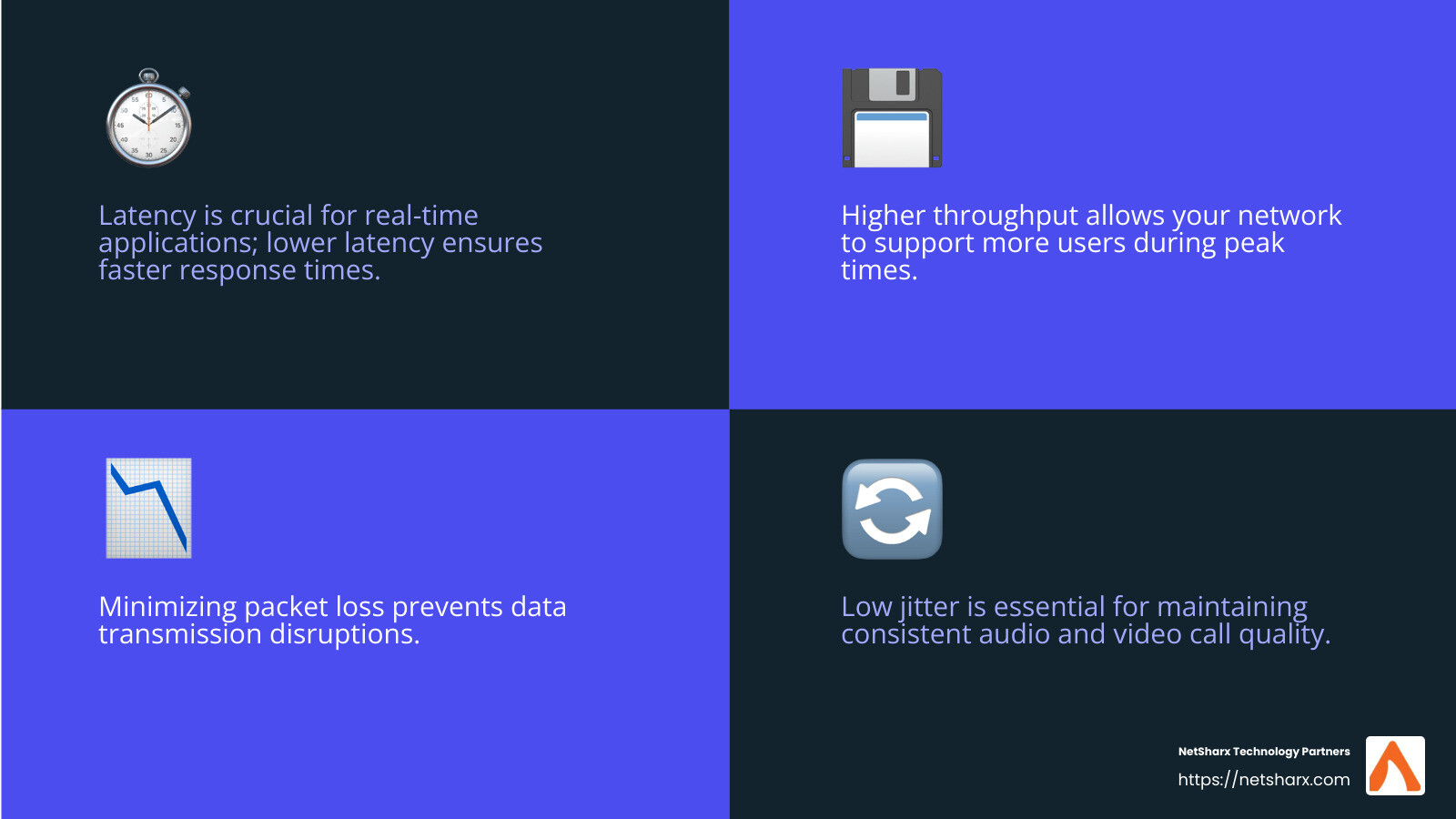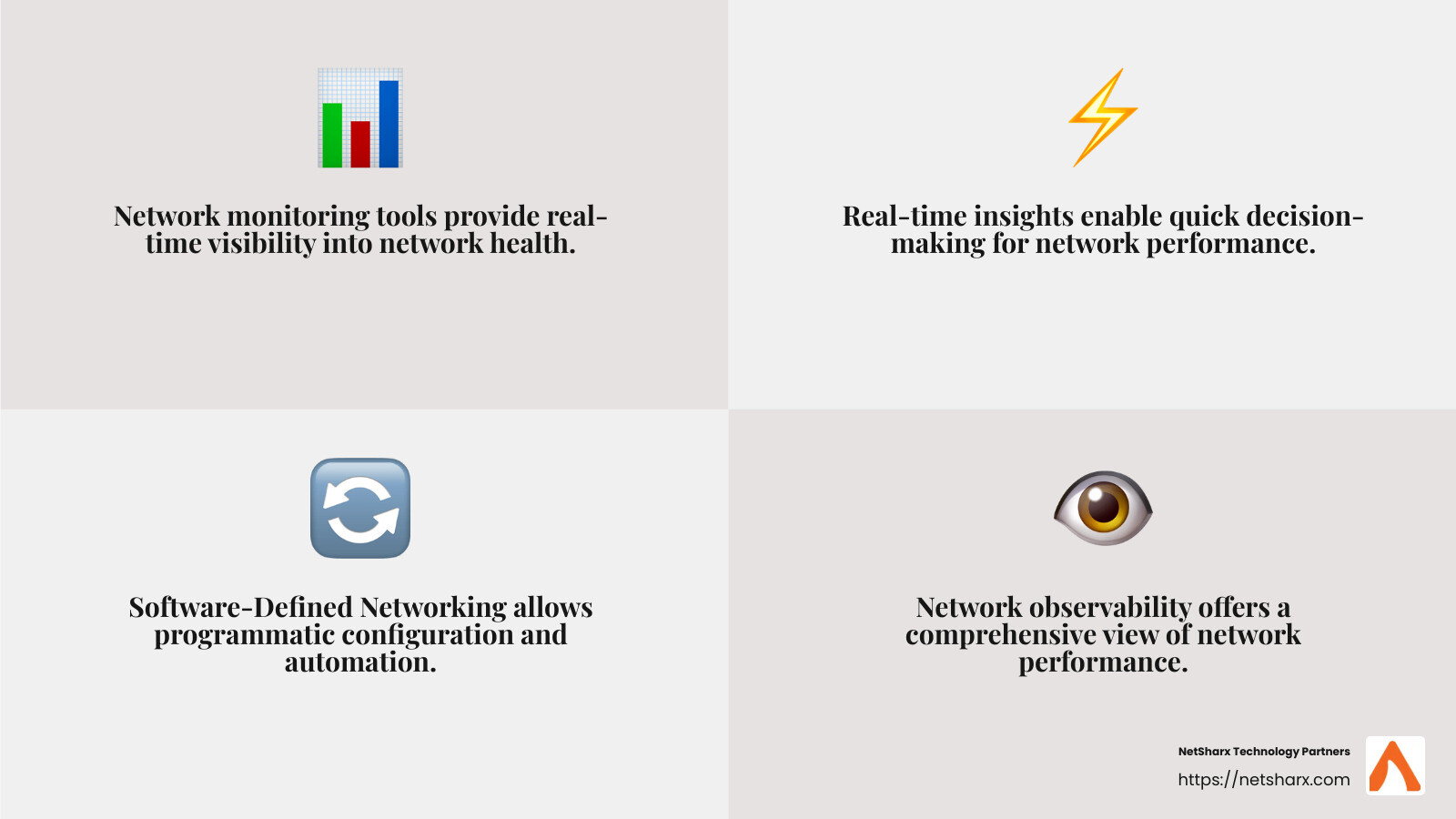Network performance optimization is the key to achieving seamless and efficient network operations, a critical factor for any tech-savvy CIO aiming to lead through rapid digital change. In today’s digital landscape, optimizing your network ensures improved speed, reliability, and security, which directly improves user experiences and business productivity.
- Speed: Optimized networks allow for faster data transmission, reducing delays.
- Reliability: Greater predictability and stability, minimizing unexpected downtimes.
- Security: Improved defense against cyber threats, safeguarding crucial data.
- Cost Efficiency: Maximizes ROI on existing infrastructure by delaying costly upgrades.
I’m Ryan Carter, CEO of NetSharx Technology Partners. With years of experience helping enterprises achieve digital change, I emphasize network performance optimization to reduce costs and improve user satisfaction.
Understanding Network Performance Optimization
Network performance optimization is like tuning a car engine. You want it to run smoothly and efficiently, without any hiccups. In technology, this means ensuring your network is fast, reliable, and secure. But how do you measure if your network is performing well? That’s where metrics come into play.
Key Metrics to Watch
To optimize network performance, start by tracking these critical metrics:
-
Latency: This is the time it takes for data to travel from one point to another. Think of it as the delay between clicking a link and seeing the page load. Lower latency means faster response times, which is crucial for real-time applications like video calls.
-
Throughput: This measures how much data your network can handle at one time. A higher throughput means your network can support more users and applications simultaneously, which is essential during peak usage times.
-
Packet Loss: When data packets fail to reach their destination, it can cause disruptions. Keeping packet loss to a minimum ensures smooth data transmission and prevents interruptions.
-
Jitter: This is the variability in packet arrival times. High jitter can lead to poor audio and video quality in calls. Keeping jitter low ensures a consistent and reliable experience.
-
Bandwidth: This is the maximum rate at which data can be transferred. Sufficient bandwidth prevents bottlenecks and ensures all applications have the resources they need.
-
Availability: This metric refers to the uptime of your network. High availability means your network is reliable and always ready for users.
-
Error Rate: This measures the number of errors in data transmission. A low error rate is crucial for maintaining data integrity and performance.
-
Response Time: This is the time it takes for your network to respond to a request. Quick response times are vital for user satisfaction and productivity.
Why These Metrics Matter
Monitoring these metrics helps you identify potential issues before they become major problems. For example, if you notice increasing latency, it might indicate a need for bandwidth management or infrastructure upgrades. By keeping an eye on these metrics, you can make informed decisions about where to focus your optimization efforts.
In summary, understanding and tracking network performance metrics is essential for effective network performance optimization. These metrics provide valuable insights into how your network is functioning and where improvements can be made to improve speed, reliability, and security.
Next, we’ll dive into specific techniques to optimize network performance, exploring strategies like traffic analysis and protocol optimization.
Key Metrics for Network Performance Optimization
In the quest for network performance optimization, keeping an eye on key metrics is like having a map for a treasure hunt. These metrics guide you to areas that need attention and improvement.
Latency
Latency is the delay before a transfer of data begins following an instruction. Imagine clicking a link and waiting for the page to load—that’s latency in action. Lower latency is crucial for activities like video conferencing and online gaming, where real-time interaction is key.
Throughput
Throughput tells you how much data is successfully transferred from one place to another in a given time frame. Think of it as the highway capacity for your data. A higher throughput means your network can handle more traffic, ensuring smooth operation even during peak periods.
Packet Loss
Packet loss occurs when data packets don’t reach their intended destination. This can disrupt services like VoIP calls or video streaming, leading to poor user experience. Minimizing packet loss is vital for maintaining seamless data flow.
Jitter
Jitter refers to the variations in packet arrival time. High jitter can make real-time communications, like video calls, choppy and unpleasant. Keeping jitter low ensures a consistent flow of data, which is essential for quality communication.
Bandwidth
Bandwidth is the maximum amount of data that can be transmitted over your network at any time. Sufficient bandwidth prevents congestion, ensuring that all applications have the resources they need to function properly.
Availability
Availability measures the uptime of your network, expressed as a percentage. High availability is crucial for businesses that rely on continuous access to network resources. It ensures that the network is reliable and ready for users whenever needed.
Error Rate
The error rate indicates the number of errors in data transmission compared to the total data sent. A low error rate is important for data integrity, ensuring that information arrives accurately and intact.
Response Time
Response time is the duration it takes for a system to respond to a request. Quick response times improve user satisfaction and productivity, making this metric a critical part of network performance.
Why These Metrics Matter
By monitoring these metrics, you can spot potential issues before they escalate. For instance, rising latency might signal the need for better bandwidth management or infrastructure improvements. Keeping tabs on these metrics allows you to make data-driven decisions, ensuring your network is always at its best.
Understanding these metrics is foundational to effective network performance optimization. They offer insights that help you improve network speed, reliability, and security.
Next, we’ll explore specific techniques to optimize network performance, diving into strategies like traffic analysis and protocol optimization.
Techniques for Network Performance Optimization
When it comes to boosting your network’s performance, several techniques can make a big difference. Let’s explore some key strategies that can help you achieve network performance optimization.
Traffic Analysis
Understanding your network’s traffic patterns is crucial. By analyzing traffic, you can identify which applications consume the most bandwidth and when peak usage occurs. Tools like Kentik’s Network Observability Cloud offer insights into bandwidth-intensive applications, allowing you to prioritize critical tasks and ensure smooth operations.
Infrastructure Design
A well-thought-out network infrastructure is the backbone of high performance. This involves selecting and configuring network hardware like routers and switches effectively. Upgrading to high-performance devices and ensuring regular firmware updates can keep your network ready for future demands. Modular designs and virtualization can also add flexibility and scalability.
Bandwidth Management
Efficient bandwidth management is key to preventing congestion. Techniques like bandwidth throttling and traffic shaping can help allocate resources to business-critical operations. By understanding how different applications use bandwidth, you can ensure vital operations run smoothly without interruption.
Protocol Optimization
Fine-tuning network protocols can improve speed and reliability. Adjustments in TCP/IP settings, such as window size and congestion control mechanisms, can lead to significant improvements. Optimizing these protocols ensures your network operates at peak efficiency.
Quality of Service (QoS)
QoS allows you to prioritize network traffic. By giving precedence to latency-sensitive services like VoIP, you can improve overall performance and user experience. This ensures that critical applications always have the resources they need.
Load Balancing
Distributing network traffic across multiple servers or connections prevents any single resource from becoming overloaded. Load balancing improves application performance and improves the end-user experience by ensuring that resources are used efficiently.
SD-WAN
Software-defined Wide Area Networks (SD-WAN) offer intelligent traffic routing and application awareness. SD-WAN can streamline WAN connectivity, improving performance and reducing costs. It’s a powerful tool for businesses with geographically dispersed locations.
Caching
Caching frequently accessed data can significantly reduce bandwidth consumption. Content Delivery Networks (CDNs) do this by storing content on multiple servers, reducing latency for users and improving their experience when accessing data.
Compression
Compression reduces the amount of data sent over the network, lowering buffer utilization. Many network devices offer this functionality, helping to optimize data flow and improve overall network efficiency.
By employing these techniques, you can improve your network’s performance and ensure it meets your business needs. Next, we’ll explore the tools and technologies available to support these optimization efforts.
Tools and Technologies for Network Performance Optimization
To achieve network performance optimization, leveraging the right tools and technologies is crucial. These solutions provide the insights and control needed to keep your network running smoothly and efficiently.
Network Monitoring
Network monitoring is the backbone of any optimization strategy. Tools like Kentik provide real-time visibility into your network’s health. By continuously tracking metrics like latency, packet loss, and throughput, you can quickly identify and address any issues before they impact operations. This proactive approach reduces downtime and helps maintain high service quality.
Real-Time Insights
Access to real-time insights is essential for understanding how your network is performing at any given moment. These insights allow IT teams to make informed decisions quickly. For instance, if a specific application is consuming too much bandwidth, you can immediately adjust settings to balance the load and maintain optimal performance.
Application Resource Management
Managing the resources allocated to various applications is key to ensuring smooth operations. By monitoring application performance, you can allocate bandwidth and other resources more effectively, prioritizing critical applications over less important ones. This ensures that all applications perform optimally, even during peak usage times.
TCP/IP Settings
Fine-tuning TCP/IP settings is another way to optimize your network. Adjusting parameters like window size and congestion control can lead to significant performance improvements. By optimizing these settings, you ensure that data flows efficiently across your network, reducing latency and improving reliability.
IPv6
Migrating to IPv6 offers long-term benefits for network optimization. With its improved addressing capabilities and better security features, IPv6 supports the latest internet standards. This makes it a future-proof choice for businesses looking to improve their network infrastructure.
Software-Defined Networking (SDN)
SDN centralizes the control plane, allowing for more programmatic configuration and automation of networks. This flexibility simplifies network management and optimization. By using SDN, businesses can quickly adapt to changing demands and improve network performance without needing extensive manual reconfiguration.
Network Observability
Network observability goes beyond basic monitoring by providing a comprehensive view of your network’s internal state. By leveraging diverse data sources, you can understand how network performance impacts business objectives and user experience. This holistic approach is essential in today’s complex networking environments.
By incorporating these tools and technologies into your network strategy, you can achieve optimal performance and ensure your network meets the demands of your business. In the next section, we’ll address some frequently asked questions about network performance optimization to help you further understand this critical process.
Frequently Asked Questions about Network Performance Optimization
What is network performance optimization?
Network performance optimization is all about making your network run as smoothly and efficiently as possible. It’s like tuning up a car to ensure it drives well. This involves improving speed, reliability, and capacity while keeping everything secure. By optimizing network performance, businesses can improve user experience, reduce costs, and increase productivity.
How do I optimize my network connection?
Optimizing your network connection can seem daunting, but it’s manageable with the right steps and tools:
-
Traffic Analysis: Start by understanding what kind of traffic is flowing through your network. This helps in identifying bottlenecks.
-
Infrastructure Design: Make sure your network design supports your business needs. This might involve upgrading hardware or rethinking your network layout.
-
Bandwidth Management: Use techniques like Quality of Service (QoS) to prioritize important traffic, ensuring that critical applications get the bandwidth they need.
-
Protocol Optimization: Configure network protocols to improve performance. Adjusting TCP/IP settings can make a significant difference.
-
Real-Time Monitoring: Implement tools for real-time network monitoring. This allows you to spot issues before they become problems.
By following these steps, you can significantly improve your network connection and ensure it meets your needs.
Should I enable network optimization?
Absolutely! Enabling network optimization brings several benefits:
-
Improved Performance: Faster data transfer and reduced latency lead to better user experiences.
-
Cost Efficiency: By optimizing resources, you can do more with less, reducing overall costs.
-
Scalability: A well-optimized network can easily adapt to growing demands.
However, there are considerations to keep in mind:
-
Initial Investment: Some optimization strategies may require upfront costs for tools or hardware upgrades.
-
Complexity: Depending on your network’s size and complexity, optimization can be a detailed process that requires expertise.
-
Continuous Monitoring: Optimization isn’t a one-time task. Continuous monitoring and adjustments are necessary to maintain performance.
By weighing these benefits and considerations, you can decide the best approach to take for your network. Implementing network performance optimization strategies can open up your network’s full potential, ensuring it supports your business effectively.
Conclusion
At NetSharx Technology Partners, we believe that achieving network nirvana is all about finding the right balance between performance, reliability, and cost. Our approach to network performance optimization is rooted in offering custom solutions custom to your unique needs. We understand that every business is different, and that’s why our solutions are not one-size-fits-all.
Our unbiased approach sets us apart. As a technology broker, we are not tied to any single provider. This allows us to objectively assess your requirements and recommend the best solutions from our extensive network of partners. Our goal is to ensure that you get the most effective and efficient network solution possible.
We pride ourselves on providing comprehensive support throughout your network optimization journey. From initial assessment to implementation and ongoing monitoring, our team of experts is here to guide you every step of the way. We offer competitive pricing, ensuring that you receive the best value for your investment.
By partnering with NetSharx Technology Partners, you can rest assured that your network is in capable hands. Our commitment to excellence and customer satisfaction drives us to deliver exceptional service and results. Let us help you open up the full potential of your network and propel your business to new heights.
For more information about how we can help optimize your network performance, visit our Network Connectivity page.





